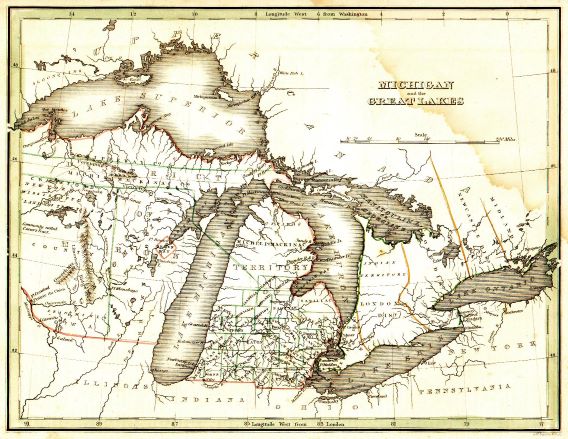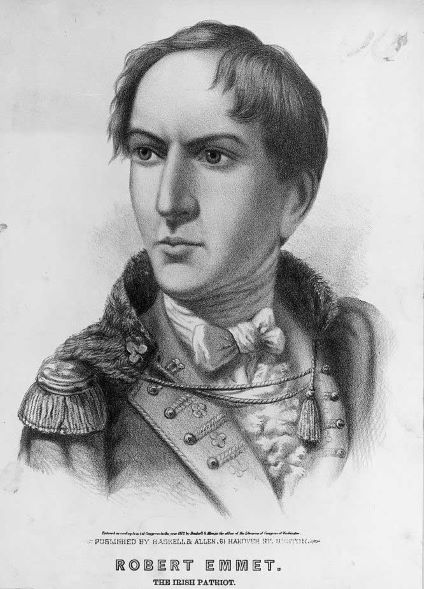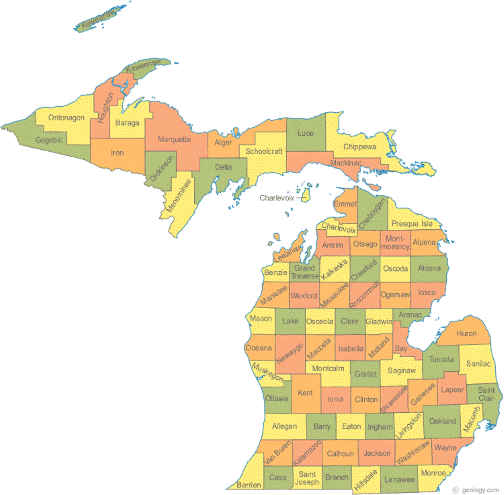Mystery Solved?
Republished from the Wolverine Café Blog of 2005

Antrim County, Clare County, Roscommon County, Wexford County. If you are from Michigan, you should recognize these as four of Michigan’s 83 counties. If you are from anywhere else in the world, you might recognize these as four of Ireland’s 32 counties.
Add Emmet County to this list and you have five Michigan counties named in the 19th Century with Ireland in the mind of the namers.
Naming rights to a location usually belong to the original settlers. It was not at all unusual for settlers to name places in North America after the original homes of the settlers. New York and Boston come to mind. Often, towns were named after the original settler – every Simpsons viewer knows that Springfield was named after Jebediah Springfield.
One could easily assume that the first settlers to these five Michigan counties were immigrants from Ireland, who chose a county name which reminded them of home.
But these five Michigan counties were not named by the settlers! Nor were there any Irish at all, to speak of, in any of these counties at the time of the naming!
So how did these counties become known as Antrim, Clare, Roscommon, Wexford and Emmet? It’s an interesting story, and we’re still not certain that we got it right. But here it is anyway:
Early Statehood and the Counties
Michigan became a state in 1837, and promptly began a program of internal improvement. This included the building of railroads, roads and canals, such as the Soo Locks Ship Canal at Sault Ste. Marie.
The state also began adding counties over the then un-settled portions of the state. Counties were intended to be the first step towards establishing government in these regions. More importantly, county creation was the first step toward surveying the land and dividing it into saleable sections – necessary to encourage settlement.

Above is a map of Michigan during the territorial period, from an 1835 atlas. Note that the lower half of the lower peninsula is divided into counties, and the upper half of the lower peninsula, all of the upper peninsula, and most of what is now Wisconsin is Michilmackinac.
The new counties were at first mere lines on a map. There were few settlers in the region, and no organized governmental units. The “locals” were the Native Americans who had yet to be displaced.
Naming rights to these new counties thus rested in those in the state capitol (then, Detroit) who were drawing the county boundaries.
The County Names
In 1840, the state legislature laid out and outlined the boundaries of the northern 29 counties. Some of the names chosen for the new counties bore tribute to the Native Americans. This was more than a bit ironic, since the natives were being moved out to make room for the settlers.
What is now Antrim County was named Meegisee, which means “eagle” and was the name of a Chippewa chief. Roscommon County was named Mikenauk after an Ottawa chief. Clare County was originally named Kaykee after another Chippewa County. Emmet County was Tonedagana County, named after another local chief. Finally, Wexford was named Kautawaubet, which means Broken Tooth and which we presume was the name of yet another local chief (or, perhaps, merely the description of someone’s body part).
In 1843, the legislature changed the names of 16 counties. Five of these were given their current Irish names. (“Antrim”, though, is misspelled “Antim” and, we understand, it was misspelled in the 1843 legislation).
But why the name changes?
We heard two theories that we were unable to verify in our research. One was that legislators realized that these Native American names were too difficult for most English-speaking Americans to either pronounce or spell. Another was that they thought that Irish county names might attract immigration to Michigan from Ireland.
The more likely explanation, though, is that the Irish had already become a political force in Michigan and the renaming of the five remote counties was an easy way to accommodate a growing block of voters.
By the time of statehood, Michigan’s lumbering industry was expanding rapidly, and many Irish, German and Dutch immigrants were arriving to fill the available jobs. Detroit’s Corktown neighborhood was thriving well before the mass immigration from Ireland’s potato famine. (Corktown continued to thrive until it was destroyed by “urban renewal” in the 1950s and 1960s).
By and large, the Irish voted with the Democratic party during this era. The Democrats controlled Michigan politics from statehood through 1839; the Whigs controlled the state in 1840 and 1841; and the Democrats regained control in 1843. It is not likely a coincidence that the Democrats were not in control when the county lines were drawn in 1840, but were in control when the counties were renamed in 1843.
Mystery Not Quite Solved
We are not totally satisfied with this answer to the question, although it seems quite logical. We have exhausted every on-line research tool available, and could not find a definitive verification of this theory.
We did find some texts with some interesting titles, on the origin of county names and the evolution of Michigan counties. I found these on “MeLCat” (Michigan electronic library catalog) and on Central Michigan University’s Clarke Historical Library on-line catalog. Unfortunately, these texts are not of the type readily available at local bookstores or at our local library. The answer may have to await our next trip to Mt. Pleasant.
It appears, though, that others gave up trying to find the answer. Consider this “explanation” in a Wexford genealogy website: “Wexford Territory, Michigan, was organized by the State Legislature in April 1840, under the Indian name of Kautawaubet (broken tooth). Three years later, an Irish name (Wexford) was selected for no significant reason”.
Also, consider this quote from the Emmet County official historic site: “The Act (of the Michigan legislature) designated it as the County of Tonedagana. Two years later another act changed the name to Emmet. Why an area with such a long and colorful Indian history was required to sacrifice its original name to some Irish patriot remains a mystery.”
It may be that the names were changed “for no significant reason”, or that the reason for the name changes “remains a mystery”.
But we think our explanation makes the most sense. If you were in the state legislature in 1843, which constituency would be more appealing to you – the declining number of non-voting Native Americans or the increasing number of voting Irish immigrants?
It’s actually surprising that only five county names were changed.
Robert Emmet

Emmet County is one of the state’s most beautiful. The county includes Petoskey, Harbor Springs, Little Traverse Bay, and the southern end of the Mackinac Bridge.
The county is named after the Irish orator and patriot, Robert Emmet. This is the short version of his story.
The American and French revolutions in the late 18th Century encouraged many in Ireland to revolt against British rule. But an armed revolt was crushed by the British army in 1798. (The British troops were commanded by Lord Cornwallis – the same general who surrendered to George Washington at Yorktown almost two decades before. This means Cornwallis’ revolution-crushing career ended up with 1 win and 1 loss).
There were a few young men in Ireland who did not accept this result. One of them was Robert Emmet.
In 1803, at the age of 24, Emmet created an organization which he hoped would seize power and set up an Irish republic. But the planned uprising was bungled from the beginning, and Emmet himself was arrested and condemned to death.
As was, and is, the custom, Emmet was allowed to address the court before it pronounced his sentence. His address was both poetic and stirring, and explains why Emmet is still remembered despite his bungled revolution.
He ended his remarks to the court with:
“Let no man write my epitaph: for as no man who my motives dare now vindicate them, let not prejudice or ignorance asperse them. Let them and me repose in obscurity and peace, and my tomb remain uninscribed, until other times, and other men, can do justice to my character; when my country takes her place among the nations of the earth, then, and only then, let my epitaph be written.”
His speech is often referred to as the Speech from the Dock.
It is reminiscent, although far longer, than Nathan Hale’s last remarks before being hanged by the British in the American Revolution: “I only regret that I have but one life to lose for my country.”
Note: “Michigan’s Irish County Names” was first published in my blog, Wolverine Café, on September 24, 2005. As was my practice in the blog, it contained many links built within the text to allow the reader a means for further exploration. I’m certain many of these linked-sites don’t exist anymore, so I didn’t use them.
